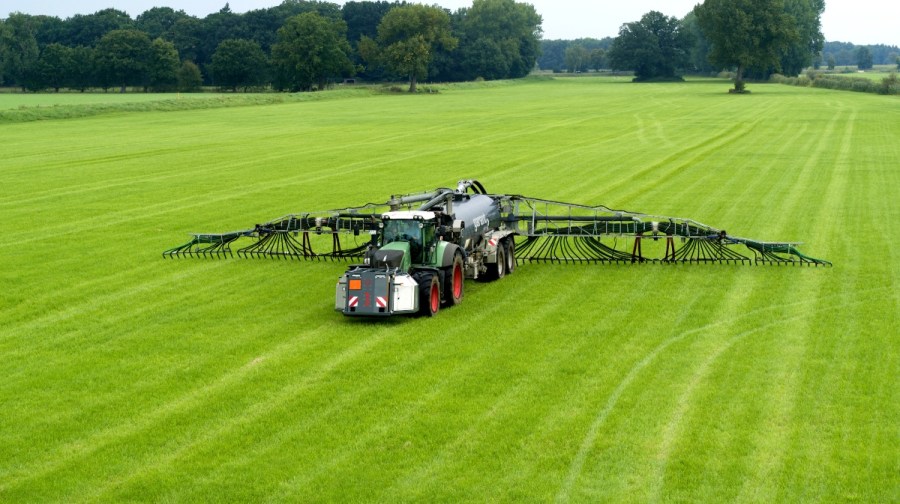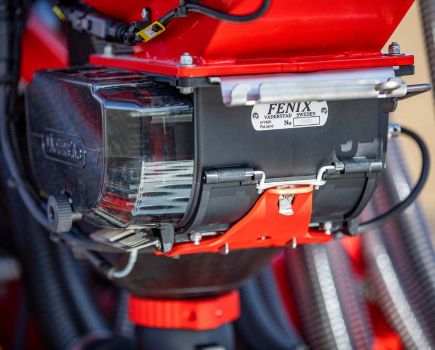Using acidification to adjust the pH of organic fertilisers could be the answer to greater efficiencies and increasing the amount of nitrogen available to crops. CPM attended a Vogelsang webinar in January to find out more.
For different slurries you need different amounts of acid to bring the pH value down.
By Melanie Jenkins
Inorganic fertiliser prices are putting a painful squeeze on margins, with many growers looking to optimise their use of organic fertilisers, but a significant amount of nitrogen is often lost before crops have the opportunity to take it up. Step up Vogelsang’s latest launch, SyreN.
Slurry, be it digestate, cow or pig manure, contains nitrogen in two forms, liquid ammonium (NH4+) and gaseous ammonia (NH3–), existing in a chemical equilibrium of roughly 60:40, explains Vogelsang’s Hubert Schmidt, during Vogelsang’s SyreN launch webinar in January. “Unfortunately, that level is relatively fixed and the gaseous portion will evaporate.”
Ammonia will evaporate at any point that slurry or digestate is exposed to air, meaning nitrogen can be lost during storage as well as after spreading. But Hubert stresses the largest amount is lost in the first 24 hours after it has been spread. And as the ammonia voltilises, the ammonium is converted to ammonia to maintain the 60:40 balance, with up to 90% of N being lost overall.
So what’s Voglesang’s answer? An on-board dosing system that adds sulphuric acid to the digestate or slurry as it’s applied to crops.
“But not all slurries are the same and organic manure is a tricky matter. For different slurries you need different amounts of acid to bring the pH value down, explains Hubert. “Cattle manure is the easiest one as it’s pretty homogenous.”
With a pH of 7, the target would be to bring it below 6.4 or to 6.2, ideally, he adds. “This would take 1.5-3 l/m³ of acid or an average of 2.5 l/m³ to get to this level.”
Trials on acidification conducted by the Lower Saxony Chamber of Agriculture (Germany’s ADAS equivalent), on a winter wheat crop in late April 2019-2021, demonstrated that 120kgN/ha of organic digestate applied with a dribble bar yielded 6.6t/ha. But by adding acidification, the yield increased to 7.4t/ha.
It was a similar story using a trailing shoe – the same application of organic digestate yielded 6.9t/ha, but with the addition of sulphuric acid this rose to 7.3t/ha.
Across both application methods, an increase in protein was also identified, going from 8% where only the organic fertiliser was applied, to 11% where acidification was used.
A further trial was undertaken to supply crops with the maximum amount of N under NVZ regulations, at 250kgN/ha, however the total ended up at 254kgN/ha. Soil samples indicated there was 50kgN/ha available, so 96kgN/ha of digestate was applied, along with 108kgN/ha of artificial supplement.
In the dribble bar trial, yields averaged 9.7t/ha without acidification but with SyreN applied, it increased to 10.2t/ha. The trailing shoe application trial yielded 9.9t/ha with and without acidification. However, both trials still saw a rise in protein from 8% up to 11%, which was attributed to the crops receiving the correct level of sulphur as a result of the acidification.
And there could be environmental benefits as well. According to the company, correct use of the system can reduce harmful ammonia emissions by up to 70%.
“The UK and EU have set out plans to reduce agricultural emissions by 2030. Treating slurry with acid delivers this and has the added benefits of increasing yield, reducing input cost and reducing the prevalence of odours that occur during application.”
So how does acidification lead to better N utilization? “The lower the pH the less evaporation of ammonia, especially in the first 24 hours,” says Hubert.
But what about the set up? The 850-litre tank is attached to the front-linkage of the tractor and is compatible with most standard band-spreading equipment.
The tank is double walled, and it operates as a closed system for safety purposes so in the event the tank is knocked or damaged, the second wall prevents acid spillage. Either side of the acid tank are compartments – one where additives for the slurry can be placed; another for water to clean the system, or for the operator in case of acid spills; and another for storing safe-handling equipment, such as gloves.
The sulphuric acid is transported via a line from the storage tank to the spreader where it’s mixed with the slurry right before going to the dribble bar. This is all controlled by a pH sensor box that measures the pH and adjusts the injection of acid to the slurry.
The acid is injected at the final point before applying the slurry, as mixing the two increases its volume massively, says Hubert. “It almost doubles in the short term, which is why the mixer is at the rear of the tank.”
The acid is also added at the end of the process because it’s effect on the slurry or digestate is only short term, and within a few days the acidifying effect diminishes – so adding it at the last minute also avoids the cost of having to top the slurry up with more acid to lower the pH again, adds Hubert.
It’s fully ISOBUS compatible and users can use their existing terminals or an independent one, depending on preference.
“There are two main application modes,” explains Hubert. One is using the pH value fertilisation, which allows for automated dosing depending on slurry flow rate. The second is sulphur fertilisation, which involves fixed acid dosing depending on slurry flow rate.
Applications can all be recorded via GPS using the Exatrek-app.
Regulation-wise, Vogelsang claims that as the tank is under 1000 litres in capacity, the operator doesn’t need an ADR licence in the UK. The company detailed that the whole tank is covered by ADR regulations and is safety proof and as a closed system, used at low dose rates, it shouldn’t be in contention with UK regulations.
Bought in high volumes, acid costs around 3p/l, and applied at 25-30 l/ha would cost around £41/ha. The full system will set users back around £85,000, but there may be government grants farmers can investigate to cover some of the cost.




